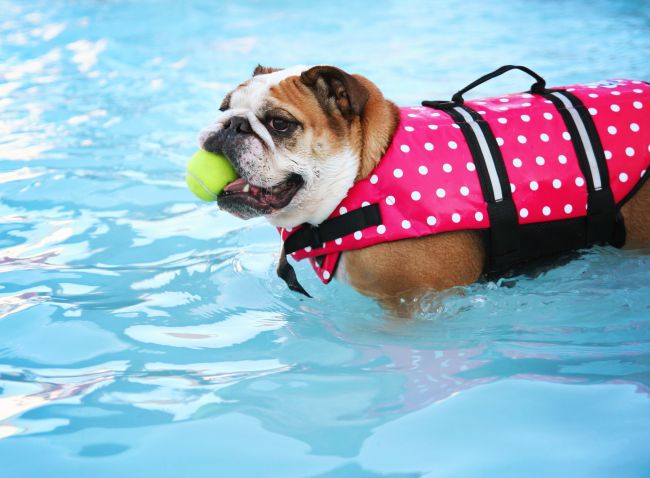
Swimming can provide an excellent relief from the scourging sun rays of summer. Though we recommend pulling out the kiddie pool so you and your pup can beat the heat, large pools can be dangerous for dogs. While retriever breeds (like Labradors and Poodles) thrive in the water, for others, it can be life-threatening. Depending on what kind of dog you have, it might be wise to establish some good “Pool Rules,” if you plan to plan to take your dog for a swim this season.
Pack a life jacket. Because there are so many stout or small dog breeds who have trouble near the water (here’s lookin’ at you, Basset hounds and Bulldogs!), many pet store sell canine life jackets. These life vests are specifically designed for a dog’s anatomy, allowing them to paddle freely, as they maneuver through the pool. With a lifejacket on, you won’t have to worry about your pup’s safety.
Prepare the dog with swim training. If your pup is a breed that can handle water, and if you are an active family that spends a fair amount of time by the ocean or in the water, then learning to swim is a necessity. While it might be challenging to find an actual swim lesson for dogs nearby, hiring a training might serve the purpose. They ought to be able to help your dog gain the skills and confidence to swim around unaided.
Prepare yourself with canine CPR. It might sound a little bizarre to invest in CPR training for dogs, but imagine how helpless you’d feel standing over your pet’s lifeless, water-soaked body without the skills to save him. Take a pet CPR training course and learn how to rescue your dog should he ever need it.
Plan to have a supervisor: Whether you have a pool or you are visiting someone with a pool, whenever your dog is around, make sure you tag-team supervising the pets with another person. This is particularly important for puppies and adolescent dogs that may be less cautious than older dogs. If an exuberant dog happens to slip in the pool unnoticed, panic can set in, causing him to swallow a lot of water. With frantic paddling and short breaths, a younger’s dog’s body can tire out quickly, especially if he is breathing water into his lungs. Make sure you have a supervisor at all times to keep watch in case an accident happens.
Keep your senior dog close by when near a body of water. While it is perfectly fine for reliable elderly dogs to enjoy going in the water themselves, make sure that someone is close by with them. Since older dogs are at greater risk of having a seizure, or arthritis and muscle cramping, anytime they go for a swim, it should be with an adult close by in case of emergencies.
Create a barrier. If the idea that your dog might get out and slip into the pool is a real possibility, it might be a good idea to limit his access. This might look like a fence around the perimeter or the pool deck, or simply a child-proof and pet-proof pool cover. Some covers are made of trampoline material, allowing people (and well-manicured pets!) to walk over them without threat of falling in or breaking the cover.

